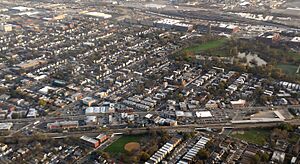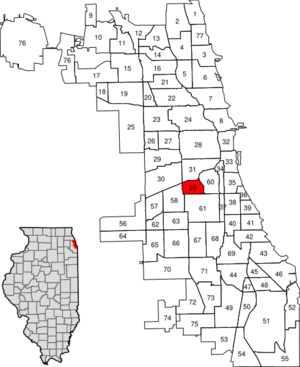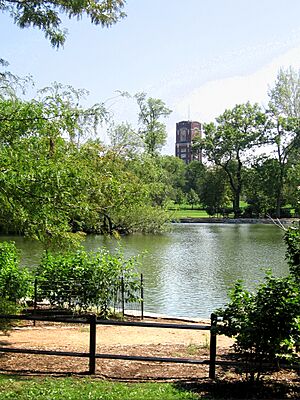McKinley Park, Chicago facts for kids
Quick facts for kids
McKinley Park
|
|
|---|---|
| Community Area 59 - McKinley Park | |

Aerial view of the McKinley Park neighborhood.
|
|

Location within the city of Chicago
|
|
| Country | |
| State | |
| County | Cook |
| City | Chicago |
| Neighborhoods |
list
McKinley Park
|
| Area | |
| • Total | 1.40 sq mi (3.63 km2) |
| Population
(2020)
|
|
| • Total | 15,923 |
| • Density | 11,361/sq mi (4,387/km2) |
| Demographics 2020 | |
| • White | 15.4% |
| • Black | 1.2% |
| • Hispanic | 52.8% |
| • Asian | 30.0% |
| • Other | 0.6% |
| Time zone | UTC-6 (CST) |
| • Summer (DST) | UTC-5 (CDT) |
| ZIP Codes |
parts of 60608 and 60609
|
| Median income | $61,814 |
| Source: U.S. Census, Record Information Services | |
McKinley Park is a cool neighborhood located on the southwest side of Chicago, Illinois. It's one of the 77 official community areas that make up this big city.
Contents
Discovering McKinley Park's Past
McKinley Park has always been a place where many working-class families lived. The area first started to be settled around 1836. This was when Irish immigrants, who were building the Illinois and Michigan Canal, began to live on small pieces of land. They used something called squatter's rights, which meant they lived there without officially owning the land.
By the 1840s, some farmers bought and drained the land. This caused the Irish squatters to move away. A town called Brighton was planned in 1840 and became an official town in 1851.
Growth and Industry
The Illinois and Michigan Canal was finished in 1848. Then, the Chicago and Alton Railroad arrived in 1857. These transportation links helped the area grow even more. During the Civil War, many factories started up along the waterways and the railroad lines.
One important factory was the Union Rolling Mill, started in 1863. It was located near the Chicago River and made a lot of steel each day. This company later became part of U.S. Steel. Many Welsh immigrants worked at the Rolling Mill and lived nearby.
Life in Early McKinley Park
Many steelworkers lived in an area called Mt. Pleasant. This name was probably a joke because of the noisy steel mills nearby. Also, much of the area was wet and swampy. This meant lots of mosquitoes! During spring floods, houses often had to be built on stilts to stay dry.
Because of the wet conditions, part of McKinley Park was even called "Ducktown." Some landowners tried to raise their land by asking people to dump ashes there. But people also dumped garbage, making the area smell bad. Even with these problems, McKinley Park became part of Chicago in 1863.
After the Great Fire
The Great Chicago Fire of 1871 caused many factories to move. A lot of them came to McKinley Park. Within five years, 11 new factories opened, mostly for iron and steel. There were also 27 brickyards. At the same time, meatpacking plants to the south grew very large. All this industry created a strong working-class community that still exists today.
Environmental Challenges
The packing houses caused a lot of pollution. They dumped waste directly into the Chicago River. One part of the river became so dirty that it was called "Bubbly Creek" because of all the bubbles on its surface. Eventually, parts of this stream had to be filled in to fix the problem.
New Industries and Transportation
While industries caused pollution, they also created many good jobs. This led to a time of great growth. In the 1870s, people from Ireland, Germany, Sweden, England, and other parts of America worked in these factories. After 1900, people from Poland and other Central European countries also moved to the area.
Transportation improved in the 1880s and 1890s with new streetcar lines. Over time, some steel mills and brickyards closed. New businesses took their place. The Central Manufacturing District started in 1905. Even today, companies like Pepsi-Cola and the Wrigley Company have plants here. The Chicago Sun-Times also built a large printing plant nearby.
The Park's Creation
After many years of people asking for one, a park was finally created at the start of the 1900s. It was named after President McKinley after he was assassinated. The park replaced an old horse racing track.
Today, the park is 69 acres and has a swimming pool and an ice-skating rink. It's a beautiful spot and is why the whole community area got its name.
Recent Changes
After a time when fewer people lived in McKinley Park, the population grew again in the 1990s. Many Mexicans joined the mix of people living there. The neighborhood has many well-kept two- and four-flat buildings. New homes are also being built. Two stops on the Orange Line train have made property values go up. They also helped a new shopping mall open on Archer and Ashland Avenue.
| Historical population | |||
|---|---|---|---|
| Census | Pop. | %± | |
| 1930 | 22,032 | — | |
| 1940 | 20,429 | −7.3% | |
| 1950 | 18,813 | −7.9% | |
| 1960 | 16,908 | −10.1% | |
| 1970 | 15,691 | −7.2% | |
| 1980 | 13,248 | −15.6% | |
| 1990 | 13,297 | 0.4% | |
| 2000 | 15,962 | 20.0% | |
| 2010 | 15,612 | −2.2% | |
| 2020 | 15,923 | 2.0% | |
Community and Culture
McKinley Park has several local newspapers that keep residents informed. These include the Bridgeport News, the Archer Journal News, and the Brighton Park/McKinley Park Life. There is also an online newspaper called the McKinley Park News. These papers are delivered weekly to homes and businesses.
Several groups that work for environmental justice are based in McKinley Park. These groups, like Neighbors for Environmental Justice and the Southwest Environmental Alliance, help protect the environment in the area.
Images for kids
-
The McKinley American Legion Post. Notice the Willis Tower in the distance.



